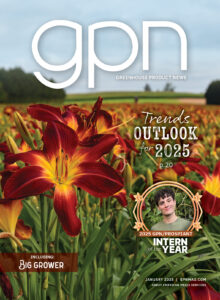Rhizoctonia Diseases on Ornamentals
In the rogue’s gallery of plant pathogens that attack important herbaceous and woody ornamentals, Rhizoctonia spp. are among the most diverse; they usually are associated with soil-line and root diseases but they can strike elsewhere.
Rhizoctonia spp. usually attack plants at the soil line, causing root loss and constriction of the stem, which results in girdling and death of the tops. But this pathogen can attack leaves as well, and is especially severe when plants are grown close together and kept moist. If conditions are optimal, entire stock beds or flats can be lost to Rhizoctonia in a few days.
The pathogen is soil-borne Ð it lives in the soil or potting medium and causes both pre- and post-emergence “damping off” of many seed-produced crops such as vinca, impatiens, stock and snapdragon.
Rhizoctonia root rot can be common in some plants including aglaonema, azalea, begonia, ferns, holly, impatiens, juniper, philodendron and spathiphyllum. In addition, Rhizoctonia can cause stem rots on impatiens, poinsettia, and pothos. Aerial blights (also called web-blight) can occur on azalea, holly, juniper and pittosporum.
When the presence of Rhizoctonia is suspected, proper identification is important because not all isolates can infect all hosts or even cause disease. Research also has shown that not all Rhizoctonia isolates cause disease on the plants they are found on.
Symptoms
Rhizoctonia aerial blight or leaf spot occurs in the warmer months, which coincide with high moisture levels. This is the case during the summer months in the southeastern U.S. when rainfall and temperatures both peak. In other areas of the country, the grower creates ideal conditions for Rhizoctonia diseases by growing plants in covered structures that are heated and irrigated overhead.
Severe disease development can occur in less than a week, so plants should be scouted and monitored for symptoms at least once a week. Brown, irregularly-shaped spots form anywhere on foliage or stems. When humidity levels are high, the web-like brown mycelium of the pathogen will cover infected portions of the plant. This is commonly seen in aerial blight, and sometimes seen when flats of seedling crops are attacked.
Rhizoctonia stem rot is characterized by the formation of brown cankers at the soil line. The cankers are sunken, appear dry, and can cause the plant tops to collapse (pg. 12). Root rot sometimes (but not always) occurs in association with stem rot.
Root rot caused by Rhizoctonia appears much like root rots caused by other fungi. Roots become brown, somewhat mushy and disintegrate. An accurate laboratory diagnosis is therefore crucial because the fungicides that control Pythium do not control Rhizoctonia, and visa versa. You must also keep in mind that mixed infections (cases where two pathogens are active) also are common. Only an accurate diagnosis will allow you to choose the best and most complete control strategies. Be sure to watch plants for above-ground signs of root rot Ð yellow or pale green leaves, small leaves, wilting and stunting.
Control
Soil-borne pathogens such as Rhizoctonia spp. can escape notice, causing serious losses before they are identified. Therefore, prevention is the key to controlling Rhizoctonia diseases. Use healthy plants, new or sterilized pots and potting media, and avoid placing plants directly on the ground whenever possible. If you follow these steps the fungicides you apply will have the greatest chance to work.
Fungicides remain an important part of ornamental plant production. Determining the application site for a fungicide control is crucial; as mentioned earlier, Rhizoctonia spp. occur in the potting medium and can cause stem and leaf diseases. Table 1 lists some of the fungicides labeled for use on ornamentals to control Rhizoctonia diseases. Since Rhizoctonia spp. can cause disease by infecting roots, cuttings, bulbs (and other types of storage organs), some situations may warrant treating nearly all parts of the plant.
The products
A quick overview of some of the product labels indicates that not all products are labeled for all uses. For example, only flutolanil (Contrast 70WSP), PCNB (Terraclor 75WP), thiophanate methyl (3336) and the biological product containing Trichoderma harzinianum (RootShield) have labels describing application to bulbs (Table 1).
Some of the products listed are ideal for foliar applications to control aerial blight, leaf spot and stem rot, but cannot be used as a soil drench for root diseases (e.g. chlorothalonil [Daconil Ultrex]). In contrast, others are specifically labeled for soil applications and cannot be sprayed onto leaves (e.g. Contrast, Terraclor and RootShield).
Only a few of those listed can be applied to leaves and roots; these include 3336, triflumizole (Terraguard 50W) and fludioxinil (Medallion 50WP). Finally, although azoxystrobin (Heritage) has been labeled for use as a foliar spray for many diseases, the label does not list Rhizoctonia aerial blights; however, it does list drench applications for Rhizoctonia.
So, we have a relatively long list of products falling into many different chemical groupings for Rhizoctonia on ornamentals (Table 2). Although resistance management is not often an issue for Rhizoctonia diseases, it is a good thing to keep in mind.
Most of the products listed in Table 1 are also helpful in fighting a myriad of other fungi-causing diseases which have been known to develop resistance to fungicides. For this reason, rotation among different chemical groupings is generally a good idea. At least eight groupings should be considered for Rhizoctonia disease control. Be sure to follow the most current label for each product Ð the label is the law.
Experimental results
Choosing fungicides based only on label recommendations can be somewhat limiting, as label revisions may be delayed. Research reports are not always reflected on labels but can indicate possible avenues for use of specific fungicides in the future. Table 3 summarizes research conducted over the past six years or so by Chase Research Gardens and a number of university scientists on Rhizoctonia diseases on ornamentals. In general, most products tested gave good to excellent control of the four diseases.
Sometimes a product appears to fail against one Rhizoctonia disease while giving excellent control of another. This occasionally can be explained by the nature of the specific disease. RootShield gave very good control of poinsettia root rot but not of damping-off of vinca or impatiens seedlings (Table 3). This is probably due to the location of the infection; protection from root infections is proven but little control is apparent of the Rhizoctonia that moves from the soil into the base of the stems. The biological agent apparently cannot protect stems, which are above the soil line when the agent is applied to the potting medium.
One of the best fungicides for Rhizoctonia diseases is Medallion 50W. The only drawback appears to be root damage to a few bedding plants such as impatiens. Medallion also controls a number of other soil-borne and foliar diseases. Flutolanil (Contrast) is specifically registered for basidiomycete fungi, which includes Rhizoctonia, Sclerotium rolfsii (the cause of Southern blight) and various rusts.
Remember that the newest products are not always the best. In a trial we conducted last year on poinsettia cutting rot, older products were compared to some that more recently entered the market. We found that excellent control was achieved with many of those tested including Chipco 26109, Medallion, 3336 and Heritage (Figure 1).
Conclusions
Fungicides labeled for application only to roots should not be sprayed onto stems and leaves. Similarly, those applied as a foliar spray should never be drenched. When products are used outside of their labels they may not work well and may cause phytotoxicity. Always read the label before using a new fungicide and reread labels once in a while, even on the products you think you know. The fungicide manufacturers and the EPA are continually at work updating our product labels, but changes are not always adequately advertised. Over the course of the next year, we anticipate seeing major changes in the REI of both Daconil Ultrex and Chipco 26019.
Disease control should never be based on the use of fungicides alone. So the following guidelines are listed for general use in preventing and controlling Rhizoctonia and other fungal diseases.
1. Clean the growing area before, as well as during, the production of a crop. All leaves and non-essential plants should be removed.
2. Always use disease-free planting materials.
3. Avoid rough handling of plants, especially when starting and ending the crop. Damaged plants are most easily infected.
4. Do no irrigate from above or expose plants to rainfall if possible.
5. Keep humidity below 93 percent. Vent and heat the greenhouse at dusk to lower the relative humidity.
6. Use fans to dry off leaves.
7. Use fungicides when necessary or according to labels. The best time to apply them is immediately after sanitation prprocedures, such as removing infected flowers and leaves.


 Video Library
Video Library 



















